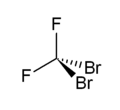Dibromodifluoromethane
Dibromodifluoromethane is a mixed halomethane. It is a colorless non-flammable liquid.
 | |
| Names | |
|---|---|
| Preferred IUPAC name
Dibromo(difluoro)methane | |
| Other names
Dibromodifluoromethane Difluorodibromomethane Carbon dibromide difluoride Carbon bromide fluoride Halon 1202 Fluorocarbon 12-B2 FC 12-B2 R 12B2 UN 1941 Freon 12B2 | |
| Identifiers | |
3D model (JSmol) |
|
| ChEMBL | |
| ChemSpider | |
| ECHA InfoCard | 100.000.805 |
| EC Number |
|
PubChem CID |
|
| RTECS number |
|
| UNII | |
CompTox Dashboard (EPA) |
|
| |
| |
| Properties | |
| CBr2F2 | |
| Molar mass | 209.82 g/mol |
| Appearance | Colourless gas/liquid |
| Density | 8.7 kg/m3 (for gas)
2.27 g/cm3 (for liquid) |
| Melting point | −101.1 °C (−150.0 °F; 172.1 K) |
| Boiling point | 22.8 °C (73.0 °F; 295.9 K) |
| Insoluble | |
| log P | 1.99 |
| Vapor pressure | 83 kPa at 20 °C |
| Hazards | |
| Main hazards | Dangerous for the environment (N) |
| S-phrases (outdated) | S23, S24/25 |
| NFPA 704 (fire diamond) | |
| Flash point | nonflammable [1] |
| NIOSH (US health exposure limits): | |
PEL (Permissible) |
TWA 100 ppm (860 mg/m3)[1] |
REL (Recommended) |
TWA 100 ppm (860 mg/m3)[1] |
IDLH (Immediate danger) |
2000 ppm[1] |
Except where otherwise noted, data are given for materials in their standard state (at 25 °C [77 °F], 100 kPa). | |
| Infobox references | |
Along with Halons 1211, 2402, and 1301, it is the most effective fire extinguishers, however, also the most toxic one.
It is a class I ozone depleting substance (ODS).
Table of physical properties
| Property | Value |
|---|---|
| Density (ρ) at 15 °C (liquid) | 2.3063 g.cm−3 |
| Critical temperature (Tc) | 198.3 °C (471.3 K) |
| Critical pressure (pc) | 4.13 MPa (40.8 bar) |
| Refractive index (n) at 20 °C, D | 1.398 |
| Dipole moment | 0.7 D |
| Ozone depletion potential (ODP) | 0.4 (CCl3F = 1) |
| Global warming potential (GWP) | 231 (CO2 = 1)[2] |
References
- NIOSH Pocket Guide to Chemical Hazards. "#0214". National Institute for Occupational Safety and Health (NIOSH).
- Hodnebrog, Ø., M. Etminan, J. S. Fuglestvedt, G. Marston, G. Myhre, C. J. Nielsen, K. P. Shine, and T. J. Wallington (2013), ‘Global warming potentials and radiative efficiencies of halocarbons and related compounds: A comprehensive review,’ Reviews of Geophysics, vol. 51, pp. 300-378, doi:10.1002/rog.20013.
External links
- International Chemical Safety Card 1419
- NIOSH Pocket Guide to Chemical Hazards. "#0214". National Institute for Occupational Safety and Health (NIOSH).
- Photolysis of dibromodifluoromethane at 265 nm
- Raman and infrared spectra of solid dibromodifluoromethane
This article is issued from Wikipedia. The text is licensed under Creative Commons - Attribution - Sharealike. Additional terms may apply for the media files.
